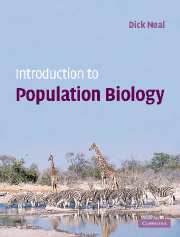Book contents
- Frontmatter
- Contents
- Preface
- Acknowledgements
- PART I Evolution by natural selection
- Chapter 1 Darwin concludes that organisms evolve
- Chapter 2 Darwin's theories of evolution
- Chapter 3 Understanding natural selection
- PART II Simple population growth models and their simulation
- PART III Population genetics and evolution
- PART IV Demography
- PART V Interactions between species, and the behaviour of individuals
- Glossary
- Solutions to problems
- References
- Index
Chapter 1 - Darwin concludes that organisms evolve
- Frontmatter
- Contents
- Preface
- Acknowledgements
- PART I Evolution by natural selection
- Chapter 1 Darwin concludes that organisms evolve
- Chapter 2 Darwin's theories of evolution
- Chapter 3 Understanding natural selection
- PART II Simple population growth models and their simulation
- PART III Population genetics and evolution
- PART IV Demography
- PART V Interactions between species, and the behaviour of individuals
- Glossary
- Solutions to problems
- References
- Index
Summary
Prior to the time of Charles Darwin, there were many fine natural history studies that shed some light on the areas of population ecology and animal behaviour. Studies on population genetics were largely related to the breeding of domesticated animals and plants. Although considerable success had been made in breeding new varieties of many species, how the characteristics of organisms were inherited remained a mystery. Carl Linnaeus had developed the binomial classification system during the previous century and collectors were roaming the globe finding ever more species and plotting the distributions of many species. The astonishing variety of organisms was becoming more and more apparent. There had also been speculation about the evolution of organisms, in fact Charles Darwin's paternal grandfather, Erasmus Darwin, had written on the subject in his book Zoonomia, but undoubtedly the most famous theory on this subject was that of Jean Baptiste de Lamarck in 1801. However, these evolutionary ideas had little scientific credence at the time when Charles Darwin was receiving his education. So we may ask: what led Charles Darwin to conclude that organisms had evolved from a common ancestor?
Charles Darwin: some important early influences (1809–31)
Charles, born in 1809, was the fifth of six children of the physician Robert Darwin and his wife Susannah. When Susannah died in 1817 the household was ruled by the triumvirate of Charles' older sisters, whilst his father was a domineering presence who had little sympathy with the antics of a small boy.
- Type
- Chapter
- Information
- Introduction to Population Biology , pp. 3 - 18Publisher: Cambridge University PressPrint publication year: 2003



